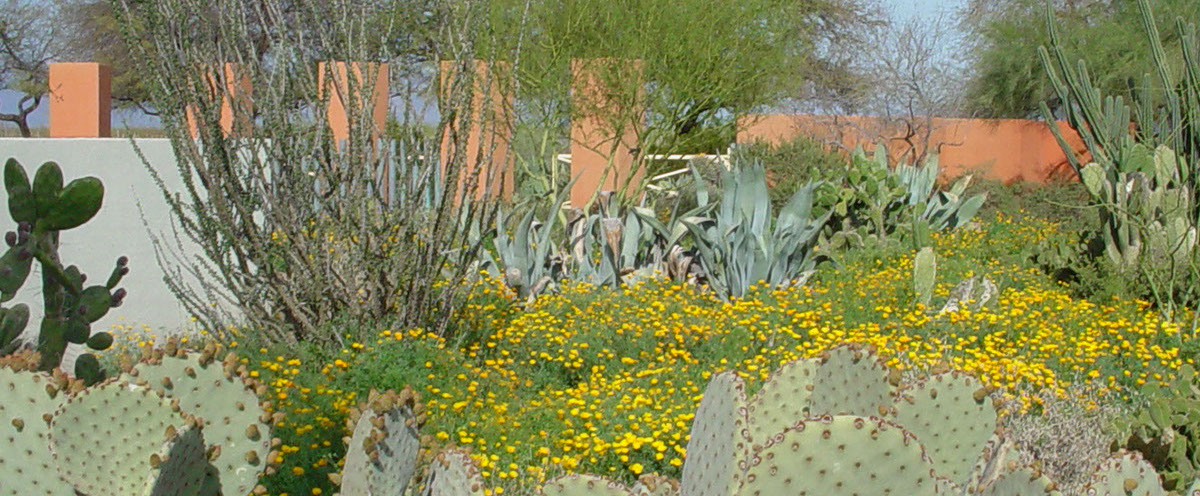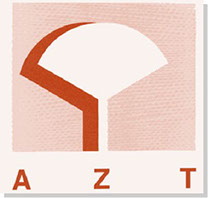


Desert Trees in Turf Areas
“In grass or not in grass?" This is a question landscape architects struggle with when designing landscapes that combine turf with desert adapted trees. The primary dilemma is will the trees tolerate the amount of water necessary to keep turf attractive and vigorous. But there are other horticultural issues that must also be considered when placing desert trees in lawns. How will the greater availability of water effect the growth of the tree? Will the maintenance of the turf create problems for the trees?
Summer Lawns: Mesquites planted in typical summer lawns grow well because the greater availability of water comes at a time of vigorous growth of the trees. The added water in combination with seasonal applications of fertilizers (primarily applied to the turf) can stimulate rapid tree growth. Initially this growth may be desirable. In the long term growth may take the form of dense leaf and branch canopies that make the trees more subject to wind throw (uprooting caused by high winds). Excessive branching may also lead to structural problems like crossing branches and die-back. Additional pruning and maintenance will be needed to manage this growth. The lack of deep irrigations will encourage shallow rooting and further contribute to wind throw risk. Supplemental deep irrigation specifically for the tree will promote the establishment of a broader deeper root system. The intense shade produced by trees like Chilean mesquites, not pruned to thin the canopy, can inhibit the growth of most common and hybrid Bermuda grasses. Shaded grasses are thinner, less vigorous and easily damaged by foot traffic.
Year Round Lawns: Winter lawns create special problems for many desert trees because large amounts of water and fertilizers are applied during seasons when desert trees should be going dormant. Semi-deciduous trees, for example, will continue to grow if water is available and temperatures are mild. Actively growing trees can be severely damaged or even killed if sudden freezes occur. Reducing or eliminating irrigations in fall and winter is an effective way of encouraging dormancy in desert trees. Winter lawns eliminate the opportunity to promote dormancy in some desert species.
Lawn Maintenance Issues: Lawn maintenance activities like mowing and trimming can damage almost any tree species planted in turf. Trees that develop little if any bark and have soft trunks like Blue and Sonoran Palo Verdes are particularly prone to injury. Tree placement, tree wells and physical barriers or guards around the base of trees can reduce the likelihood of damage.
Trees that generally tolerate lawn planting include:
Mesquites (all species);
Sweet Acacia (Acacia smallii)
Chaste Trees (Vitex agnus-castus)
Mexican Palo Verde (Parkinsonia aculeata)
Guajillo (Acacia berlandieri)
Desert Willow (Chilopsis linearis)
Shoestring Acacia (Acacia stenophylla)
Mescal Bean (Sophora secundiflora)
Trees that are not well suited for planting in lawns:
Blue Palo Verde (Cercidium floridum)
Sonoran Palo Verde (Cercidium praecox)
Foothill Palo Verde (Cercidium microphyllum)
Mulga (Acacia aneura)
Ironwood (Olneya tesota)
Leather Leaf Acacia (Acacia craspedocarpa)
This is not to suggest that it is impossible to maintain any of the trees listed above successfully in lawns. Rather that these trees will require special care, attention and management to survive in these settings.
In Summary, several factors must be considered when planting desert trees in turf areas: 1) is the year round maintenance and irrigation of the turf compatible with the species of trees; 2) will the growth of the trees adversely affect the turf; and 3) does the additional maintenance, care and potential risks of tree death justify the use of this specie in a turf area.

© Copyright 2000-2020 Arid Zone Trees